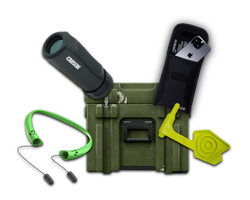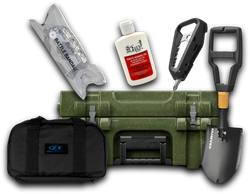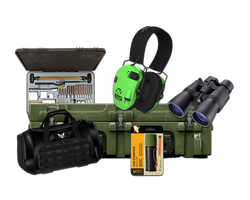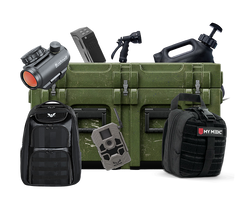Can You Target Shoot in National Forests?
Table of Contents
- Introduction
- Understanding National Forest Regulations
- Safety Considerations for Target Shooting
- Best Practices for Target Shooting in National Forests
- Conclusion
Introduction
Imagine standing amidst the towering pines of a national forest, the sun filtering through the leaves, and the sound of nature surrounding you. Now, picture yourself aiming at a target, the anticipation building as you prepare to pull the trigger. For many outdoor enthusiasts and firearms users, this scenario embodies the thrill of target shooting in the great outdoors. But can you legally do this in national forests? The answer is nuanced, depending on a variety of factors including local regulations, safety, and environmental considerations.
The landscape of target shooting in national forests is complex and ever-evolving. As outdoor recreation has surged in popularity, so too have concerns about safety, wildlife protection, and environmental stewardship. This post aims to provide a thorough understanding of the legalities and best practices associated with target shooting in national forests across the United States. By the end of this article, you will have a comprehensive overview of what you need to know before heading out for a day of shooting in the wild.
We will explore the general rules governing target shooting in national forests, the restrictions that may apply, safety measures to consider, and the best practices to ensure that your shooting experience is not only enjoyable but also responsible. Additionally, we'll provide insights into the resources available to help you navigate these regulations effectively.
Understanding National Forest Regulations
The Legal Framework
The legality of target shooting in national forests is primarily governed by federal regulations, but it also varies significantly by state and local jurisdiction. Generally, the U.S. Forest Service allows target shooting in most national forests unless specific restrictions are in place. It is crucial to understand that national forests differ from national parks, where firearms regulations are much stricter.
-
Federal Regulations: According to the U.S. Forest Service, target shooting is allowed in designated areas of national forests. However, this is subject to state laws and local forest district regulations.
-
State and Local Laws: Each state has its own laws regarding the discharge of firearms, which can affect where and how you can shoot. For example, some states may have specific restrictions on the type of firearms that can be used, the proximity to populated areas, and designated shooting zones.
-
Consult Local Forest Offices: Before heading out, it's imperative to check with your local ranger district. Each ranger district may have different rules and regulations regarding target shooting, including any temporary closures or restrictions due to wildlife protection or fire hazards.
Common Restrictions
While many national forests permit target shooting, there are common restrictions you should be aware of:
- Distance from Structures: Shooting is typically prohibited within 150 yards of residences, developed recreation areas, and campsites.
- Shooting Over Roads or Water: It is illegal to shoot across or along any national forest road or body of water.
- Backdrops: Always ensure that a proper backstop is in place to catch stray bullets. Shooting into vegetation or structures like trees is discouraged.
- Approved Targets: Certain types of targets (like exploding targets) may be banned in many forests due to fire hazards and safety concerns. Stick to paper, cardboard, or biodegradable targets.
- Littering: It is your responsibility to clean up after shooting. Leaving behind spent casings, targets, or other debris is prohibited.
Fire Restrictions
Fire restrictions can significantly impact shooting activities, especially during dry seasons when the risk of wildfires is elevated. In such cases, the U.S. Forest Service may impose temporary bans on target shooting. Always check for current fire restrictions before planning your shooting trip.
Safety Considerations for Target Shooting
Safety is paramount when engaging in any shooting activity, especially in shared spaces like national forests. Here are essential safety guidelines to follow:
Basic Gun Safety Rules
- Treat Every Firearm as if It's Loaded: Always assume that a firearm is loaded, even if you believe it's not.
- Muzzle Control: Never point your firearm at anything you do not intend to shoot. Keep the muzzle pointed in a safe direction at all times.
- Finger Off the Trigger: Keep your finger off the trigger until you are ready to shoot. This helps prevent accidental discharges.
- Know Your Target and Beyond: Always be aware of what you are shooting at and what lies beyond your target. This is particularly important in open areas where people or wildlife may be present.
Environmental Awareness
- Wildlife: Understand that national forests are habitats for various wildlife. Be mindful of your surroundings, and avoid shooting in areas where wildlife is prevalent, especially during breeding seasons.
- Fires: The risk of wildfires is a significant concern. Always adhere to local fire restrictions, and avoid shooting during high-risk times.
Responsible Shooting Practices
- Choose a Safe Location: Select a shooting area away from trails, campsites, and roads. Ensure that no one else is in the vicinity when you begin shooting.
- Use a Proper Backstop: Ensure that your shooting area has a solid backstop to prevent bullets from traveling beyond your intended range. Hillsides or berms work well as backstops.
- Bring Your Own Targets: Carry targets and target stands to avoid attaching anything to trees or natural formations, which can damage the environment.
Cleanup Protocol
After your shooting session, it is critical to leave the area cleaner than you found it. This includes:
- Picking up all spent casings.
- Taking your targets and any trash with you.
- Ensuring that no debris is left behind that could harm wildlife or other visitors.
Best Practices for Target Shooting in National Forests
Planning Your Shoot
Before heading out to target shoot, planning is essential. Here are some tips to ensure a successful and enjoyable experience:
- Research the Area: Investigate the specific national forest you plan to visit. Check its website for information on shooting regulations, available maps, and local ranger contact information.
- Make a Safety Plan: Discuss your safety plan with your shooting partners. Agree on a designated shooting area and establish clear communication protocols.
- Consider Timing: Choose a time when the forest is less crowded. Early mornings or weekdays may be ideal to minimize the chances of encountering other people.
Engage with the Community
The shooting community is vast, and many enthusiasts share valuable information about their experiences in national forests. Engaging with local shooting clubs or online forums can provide insights into the best practices and tips for shooting in specific areas.
Explore Resources
For those looking to enhance their shooting gear and preparedness, Crate Club offers a subscription service for tactical gear and survival tools tailored to your needs. Their curated selection ensures that you receive high-quality equipment every month, empowering you to be well-prepared for your outdoor adventures. Check out the Crate Club Subscription Services for more details.
Conclusion
In summary, target shooting in national forests can be a rewarding outdoor activity, provided that you adhere to local regulations and prioritize safety. Understanding the legal framework, common restrictions, and best practices is essential for a responsible shooting experience.
As you prepare for your next shooting outing, remember to respect the environment, wildlife, and fellow nature enthusiasts. By doing so, you not only enjoy your time in the great outdoors but also contribute positively to the community of outdoor lovers.
For those who are looking to enhance their gear and be better prepared for outdoor shooting and survival, consider exploring the Crate Club Shop for a wide array of tactical gear that can elevate your experience.
FAQ
1. Can I target shoot in any national forest?
Not all national forests allow target shooting. Always check with your local ranger district for specific regulations and restrictions.
2. What type of targets can I use?
You should use approved targets, such as paper or cardboard. Exploding targets are often prohibited due to safety concerns.
3. Are there distance restrictions for shooting near structures?
Yes, shooting is typically prohibited within 150 yards of residences, developed recreation areas, and campsites.
4. What should I bring for a day of target shooting?
Bring your firearm, ammunition, approved targets, a proper backstop, safety gear (like ear and eye protection), and supplies for cleanup (trash bags, etc.).
5. What should I do if I encounter wildlife while shooting?
If you encounter wildlife, cease shooting immediately and give the animals space. Avoid shooting in areas known for high wildlife activity.
By following the guidelines outlined in this article, you can ensure a safe and enjoyable target shooting experience in our national forests. Always prioritize safety and responsibility to enjoy your time in the great outdoors fully.
Share this article



